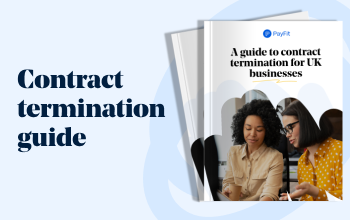✨ Health insurance, now in PayFit - learn more
💷 All the rates & thresholds you need to know for 25/26...right here
✨ The Payroll Journey: Start, Scale & Succeed Globally - learn more
✨ Health insurance, now in PayFit - learn more
💷 All the rates & thresholds you need to know for 25/26...right here
✨ The Payroll Journey: Start, Scale & Succeed Globally - learn more

Here are the key points to understand about voluntary redundancy:
Growing a business is a dynamic process, and will often involve some restructuring or the adoption of new technologies at various points in time. Such changes can sometimes mean that specific job roles are no longer needed, creating a redundancy situation.
Many managers dread redundancy, often picturing a harrowing compulsory process. However, there is a neat alternative approach: voluntary redundancy.
Managed correctly, voluntary redundancy can be a much more humane and efficient way to resize. It gives employees their own control over the decision, and can help preserve morale among your remaining staff. But it is a formal procedure nonetheless. It’s not as simple as asking people to stick their hand up and quit.
This article provides useful advice for HR, finance and business leaders on the formal framework, financial implications, and best practices for voluntary redundancy.
When a business identifies a requirement to reduce its headcount, it faces a choice. The compulsory route involves a formal selection procedure that can be highly stressful for all involved.
Offering voluntary redundancy first is a powerful tool. It avoids the anxiety and survivor guilt of compulsory cuts. And it’s typically faster. Employees who are perhaps already considering a career move or retirement can accept favourable terms and leave on positive terms.
This also protects your employer brand. It demonstrates social responsibility, and can reduce the risk of tribunal claims, as it is clear that the employee is going voluntarily. The trade-off is often a higher cost, as the financial incentive must be attractive enough to encourage applications.
You must follow a fair and compliant redundancy process. Even though it’s voluntary, it is still classed as a termination, so you still have to respect certain obligations.
First, a genuine redundancy situation must exist, as defined in UK employment law, which defines redundancy rights. This typically happens when any of the following conditions occur:
The business is closing down.
The workplace where the employee is based is closing.
The business’s demand for a specific job or role has reduced or no longer exists.
You must be able to prove this. You cannot offer a voluntary redundancy incentive simply because you want someone to leave. That would be a sham, and could easily lead to an employment tribunal.
Consultation is not optional. You must consult all at-risk employees, even if you expect to get enough volunteers.
You must explain why redundancies are necessary, the number of roles affected, and the proposed selection method.
If you are making 20 or more employees redundant at one establishment within a 90-day period, formal collective consultation rules apply. This involves specific timelines (e.g. 30 or 45 days) and formal consultation with employee representatives.
Failure to consult properly can lead to a Protective Award, that is, a penalty of up to 90 days’ gross pay per affected employee.
Once the consultation has begun, you can invite employees to apply for voluntary redundancy. The proposal should be made in writing. And it must clearly state the terms, financial payment, timeline for applications, and proposed leaving date.
Crucially, it must state that the business reserves the option to reject applications.

Contract Termination Guide
You do not have to accept every application. The business must retain the skills it needs to move forward.
If you are oversubscribed, you must take the time to use fair, objective selection criteria to decide who and who not to accept. If you receive too few applications, you may still have to proceed with compulsory redundancies from the remaining pool.
Your selection criteria must not be unfairly discriminatory. For example, you cannot simply accept all the older, more expensive employees who apply, as this would count as age discrimination. Your criteria should be based only on factors relevant to future needs, such as:
Skills, qualifications, and experience.
Performance and aptitude records.
Attendance and disciplinary records.
The final decision rests with the employer. But make the criteria clear, in case an employee wishes to appeal the decision.
This is where HR and finance managers must work closely. The payment is the main incentive. It must be attractive enough for people to want to volunteer. It typically has several components as we shall see below.
Any employee with two or more years of continuous employment is entitled to Statutory Redundancy Pay. This is the minimum required by law.
It is calculated based on three factors:
The employee’s age.
Their length of service (capped at 20 years).
Their Average Weekly Pay (capped at a government-set limit, which changes each tax year).
The formula is complex:
Half a week’s pay for each full year of service with the employee under 22 years old.
1 week’s pay for each full year of service with the employee 22 or older, but under 41.
1.5 weeks’ pay for each full year of service with the employee 41 or older.
You must accurately calculate this minimum, which you can estimate using the official GOV.UK calculator, or you’ll find it already automated in good HR and payroll software, such as PayFit’s.
No-one will volunteer if you offer just the minimum, and the redundancy won’t technically be considered voluntary either.
People will begin to volunteer when there is an enhanced severance payment on top of the SRP. And this financial incentive is actually what makes the redundancy voluntary.
There is no set formula for calculating the amount. It is rather a commercial decision for the business. It might be a multiplier of SRP, or a formula like ‘one month’s pay per year worked’. This enhanced payment is a really fundamental part of the proposal.
The final payment doesn’t just involve SRP and enhanced redundancy pay. You must also account for other redundancy and termination payments:
Notice pay: The employee is entitled to their full statutory or contractual notice period. You must decide whether you want them to work this period, or whether you will offer them a Payment in Lieu of Notice (PILON).
Holiday pay: You must pay for all accrued but untaken holidays up to the termination date.
Other benefits: Consider the impact on pensions, share schemes, and other contractual benefits.
The first £30,000 of a redundancy payment (including the enhanced parts) is usually tax-free. However, PILON and holiday pay are taxed as normal income.
Managing the admin and finance for this is a significant burden. This is especially true for growing businesses, in which HR and finance teams are already stretched.
You will need to model different cost scenarios. For example, you should calculate the final pay for multiple employees, each with different lengths of service and contracts. These complex final pay calculations, including enhanced elements, is where automated systems truly excel.
Modern payroll platforms, like PayFit’s payroll software, ensure every part of the final severance payment is compliant and accurate. They handle the complex tax treatment of the payment and work out the final holiday pay, in order to process leavers fairly and correctly.
Managing the leaver procedure effectively is vital. Integrated HR software can streamline everything from issuing formal letters to securely handling settlement agreements and exit documentation, giving managers the help they need to focus on supporting their people to the best of their abilities.

No. It is always an invitation from the company. An employee can request it, but there is no legal entitlement to be made redundant. The decision to offer it, and to whom, rests with the company.
Yes. You can, and should, refuse a request if the employee has skills that the business needs to retain. As long as the selection criteria for accepting or rejecting applications are fair and objective, this is perfectly acceptable.
The employer must confirm the decision in writing and give a termination date and a breakdown of the employee’s final payments. It is best practice to ask the employee to sign a formal settlement agreement. This is a legal document where the employee agrees to waive their rights to make future claims (such as for unfair termination or discrimination) in exchange for the enhanced redundancy payment.
These are very different. Voluntary redundancy is a formal, agreed-upon procedure by which an employee volunteers to be terminated for a fair reason (redundancy) in exchange for a financial payment. Constructive dismissal is when an employee is forced to resign against their will because the employer has fundamentally breached the employment contract, making their job untenable, and may lead to constructive dismissal compensation decided by an employment tribunal.
For impartial advice on obligations, both employers and employees can consult the Advisory, Conciliation and Arbitration Service (ACAS). If the situation moves beyond voluntary to a compulsory dismissal, it’s vital you follow a fair procedure, as outlined by the government.

Learn what constructive dismissal compensation is, how it’s calculated, and the best practices UK employers should follow to avoid costly tribunal claims.

Employee handbooks give new and existing employees the chance to access important information about your company and its policies. Learn more.

Our guide helps managers understand UK redundancy rights & efficiently handle redundancy, calculate pay, ensure compliance & avoid costly tribunal claims.

This article provides guidance on the redundancy process, to help UK employers understand their obligations and the rights of their employees.

Contract terminations aren’t easy. This guide covers what to do as an employer when you have a redundancy, settlement agreement, death or non-starter.